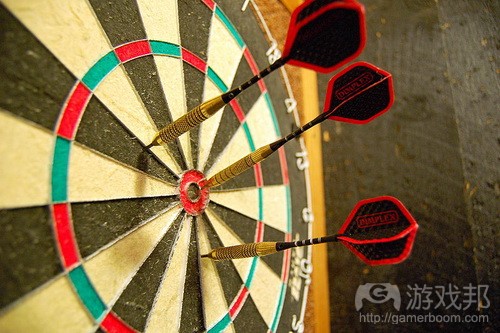游戏功能的趣味性远胜过内容的多样性
你现在手中有一个机制,假设是一个能够掷飞镖的机制。而且你需要在1周内将此呈现给大众。
此掷飞镖机制也许有不错的界面。镖盘也许过小或过大,或者光线略有不足。飞镖也许是个不错的构思,但内容的执行方式有待改善。
此时,你已设计出一个功能,但功能不怎么有趣。要将其变得颇有趣味,你需要投入4天时间。
你可以改善飞镖,将其变得有趣。创造优质UI,设计杰出的物理模式和控制装置,再来就是丰富的画面,总之,你可以打造出一个有趣的功能。
这里的操作涉及3个层面:确保输入内容合理分布于用户地图中,这是基于“黑盒”角度,也就是所谓的飞镖机制;确保飞镖机制本身能够提供有趣的重复挑战;确保黑盒的反馈信息既生动,又富有教育意义,这样用户就会更擅长飞镖。所有这些都非常困难。
然后你就面临一个选择。在将飞镖变得富有趣味之后,你只剩下3天时间。你可以选择融入一个台球桌,或者你可以在飞镖中添加内容。这些内容就是新飞镖类型,更多类型的飞镖游戏等。它们不需要你添加新的机制,只会需要其他类型的数据。这里不会有太多的新代码(游戏邦注:新代码存在带来漏洞的风险)。若你在此投入3天时间,你可以制作最优秀的飞镖游戏。
你也可以转而选择引入台球桌。但若和之前的飞镖一样,首次尝试觉得这并不怎么有趣结果会怎样?那么你就拥有一款不错的飞镖游戏及一款蹩脚的台球游戏。
哪个会更好呢?创作出最优秀的飞镖游戏,或是获得一款中等飞镖游戏和一个糟糕台球桌元素?
添加功能能够带来新的趣味性,但趣味性源自于调节和平衡。并不是说你融入一个台球桌,趣味性就会神奇般地出现。
按照顺序,我需要先处理黑盒,然后是输入内容,最后是反馈信息。我无法通过更优秀的支持元素将糟糕的机制变得更杰出,虽然我可以将其变得更生动,但这通常无法赢得玩家的芳心。
我会选择完善飞镖,然后承诺尽快融入台球桌。待到我真正融入台球桌元素时,我们呈现的是最佳状态的内容,而不是被迫在最后期限前融入这一元素。
在我的职业生涯中,我并非总是能够这么进行选择的。我也进行许多激进现实主义的设计。我也经常不得不迁就于糟糕的支撑元素和反馈信息。我们甚至还曾将非常优秀的机制弃置一旁,因为我们无法解决让反馈信息易于理解的问题。
我总是倾向选择精致的机制,是指变量和规则很少的机制。若你在游戏中融入众多这类元素, 它们通常会带来突发性行为,这能够带来趣味性。但若你着眼于创建简单系统,你更易于在此融入众多变量和规则,这会令这些元素显得有些粗制滥造。
我很擅于提出简单额规则的解决方案,当中有10%能够在初次试验中顺利运作。但这些天,我发现,改善和调整规则机制要比最初提出这些规则多耗费10倍的时间。(本文为游戏邦/gamerboom.com编译,拒绝任何不保留版权的转载,如需转载请联系:游戏邦)
Fun vs features
You have a system. Let’s say it’s a system where you can throw darts. And you have to open your bar in one week.
Throwing darts might have a bad interface. The dartboard might be too small or too big or poorly lit. Darts may be a perfectly nice idea, but the implementation of it needs tuning.
At this point, you have a feature, but not fun. It’s gonna take you four days to make it fun.
You can refine darts, get it fun. Make the UI good, have a great physics model and control, great graphics, and in general, you can get it to where you have a fun feature.
The exercise here is going to be threefold: making sure the inputs afforded to the user map well to their view of the “black box” that is the darts system; making sure the darts system itself offers interesting repeatable challenges; and making sure that the feedback from the black box Is both juicy and educational, so that the user can get better at darts. All this is hard.
Then you face a choice. Three days left, if you made darts fun. You can either go implement a pool table, or you can add content to darts. Content would be new kinds of darts, more kinds of dart games, etc. They don’t call for a new system, just other kinds of data. Not much new code (and new code runs the risk of introducing bugs). You can make the best darn darts game in the country if you spent the three days on that.
The pool table, you could get that in instead. But what if it’s not fun on the first try, just like darts weren’t? Then you’d have a decent darts game and a crappy pool table.
Which is better, having the best darts game available, or having a middling darts game and a bad game of pool?
Adding features offers the potential for fun, but fun comes from tuning and balancing. It isn’t magically there just because you got a pool table.
In order, I would have to tackle the black box, then the inputs, and finally the feedback. I can’t make a bad system much better with great affordances and while I can make it juicy, it usually won’t hold players.
I would choose to polish up darts, and promise to get a pool table in there as soon as I can. And when I do put in the pool table, it’ll be as good a game of pool as we can make rather than being rushed to fit in before the bar opens.
This isn’t the answer I would always have chosen in my career. I have done plenty of kitchen sink design. I have also settled for poor affordances and feedback far too often. I have even had perfectly wonderful systems be unusable because we could not figure out a way to make the feedback comprehensible.
I’ve always leaned towards elegant systems, meaning ones with few variables and few rules to them. When you populate a game with many of these, they very frequently end up leading to emergent behavior, which can be quite fun. But when you lean on the creation of simple systems, the temptation is even greater to have lots of them in your game. And that can and will lead to most or all of them feeling unpolished and unfinished.
I’ve gotten good enough at coming up with simple rule solutions that gosh, almost 10% of them work on the first try! (Yes, read that as sarcasm aimed at myself). But these days, I tend to assume that it will take me ten times longer to polish up and tune that rule system than it will to come up with the rules in the first place.(Source:raphkoster)









































